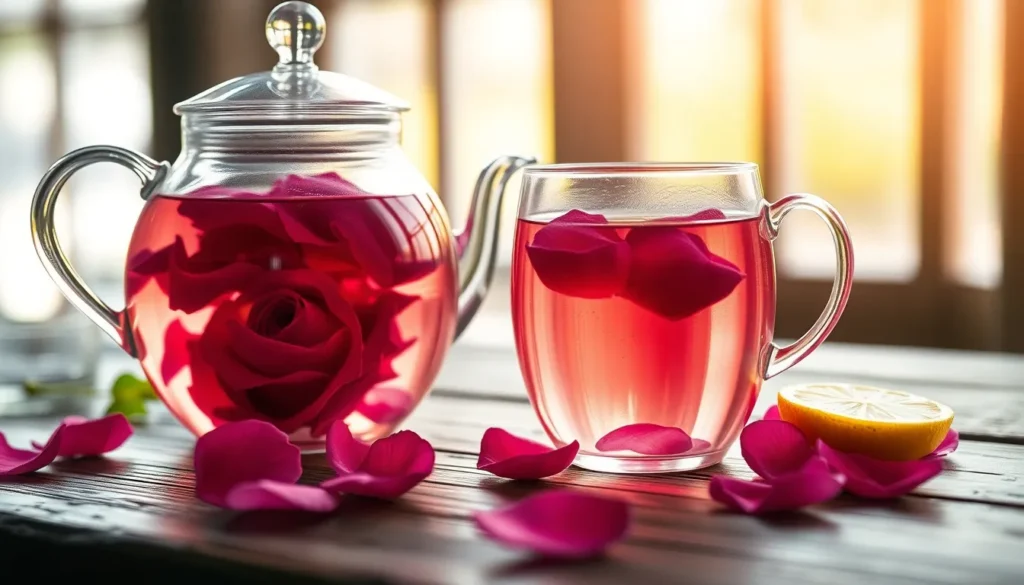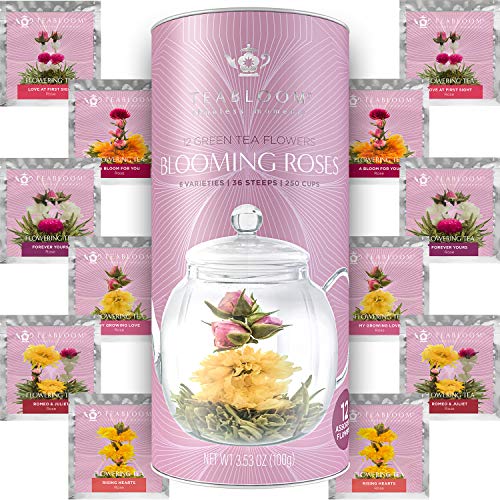Transform your tea ritual into a luxurious floral escape with this enchanting rose petal tea recipe. We’ve discovered that brewing fresh or dried rose petals creates a delicate and aromatic beverage that’s been cherished across cultures for centuries. This beautiful pink-hued tea isn’t just Instagram-worthy – it’s packed with antioxidants and offers a naturally soothing experience that’ll elevate your daily wellness routine.
Creating rose petal tea at home is surprisingly simple and costs a fraction of what you’d pay at upscale cafes. We’ll show you how to select the right rose varieties, properly prepare the petals, and achieve that perfect balance of floral fragrance without overwhelming bitterness. Whether you’re using petals from your garden or premium dried roses, this recipe delivers consistent results every time.
Ready to impress your guests or treat yourself to something extraordinary? This rose petal tea recipe transforms an ordinary afternoon into a spa-like experience that soothes both body and mind.
Ingredients
We need just a few simple ingredients to create this elegant rose petal tea that delivers both beauty and flavor in every cup.
For the Rose Petal Tea:
- 2 tablespoons fresh rose petals (or 1 tablespoon dried rose petals)
- 2 cups filtered water
- 1 teaspoon honey (optional, for sweetening)
- 1/2 teaspoon fresh lemon juice (optional, for enhanced flavor)
Essential Ingredient Notes:
Rose petals form the heart of this recipe and require careful selection. We recommend using organic roses that have never been treated with pesticides or chemicals. Damascus roses, Centifolia roses, or Rosa gallica varieties work exceptionally well due to their intense fragrance and flavor profile.
Fresh rose petals should appear vibrant in color with no brown edges or wilting. We gather these in the early morning when their essential oils are most concentrated. Dried rose petals offer convenience and can be stored for months when kept in an airtight container away from direct sunlight.
Filtered water ensures the pure taste of rose petals shines through without interference from chlorine or other additives found in tap water. The water temperature plays a crucial role in extracting the delicate floral compounds without creating bitterness.
Honey serves as our preferred natural sweetener because it complements the floral notes without overpowering them. Raw honey adds depth while maintaining the tea’s elegant character.
Lemon juice brightens the overall flavor and helps preserve the tea’s beautiful pink hue. We add this sparingly to enhance rather than dominate the rose essence.
Equipment Needed
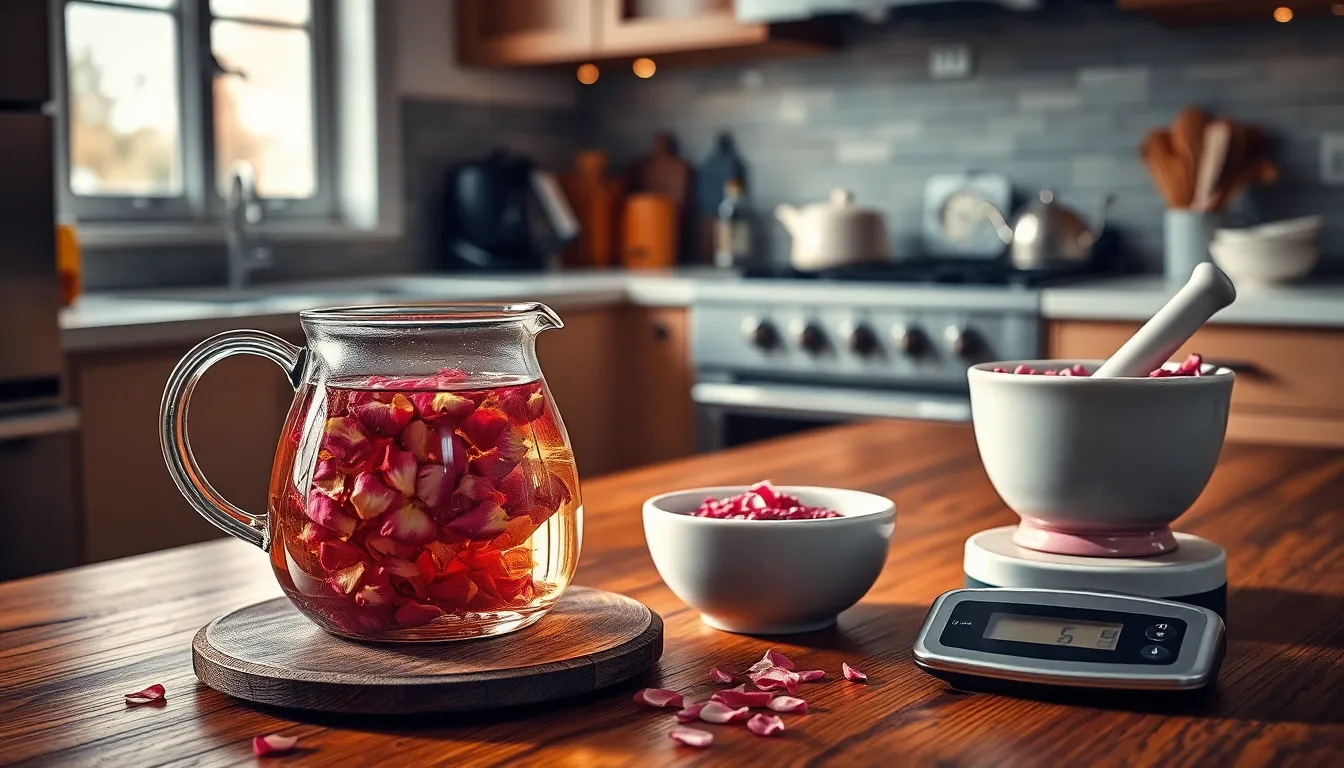
Making rose petal tea requires minimal equipment that most of us already have in our kitchens. We recommend gathering these essential tools before starting the brewing process to ensure a smooth and enjoyable tea-making experience.
Tea cup with infuser or glass teapot with infuser serves as our primary brewing vessel. These tools make loose tea steeping incredibly easy and allow us to remove the petals effortlessly once the desired strength is achieved. Glass teapots offer the added benefit of letting us watch the beautiful color transformation as the rose petals release their essence.
Kettle becomes essential for heating water to the proper temperature. We can use any standard stovetop or electric kettle for this purpose. A saucepan works as an alternative if we don’t have a kettle available.
Mortar and pestle helps us gently crush rose petals to release their maximum flavor potential. This optional tool proves particularly useful when working with dried petals that benefit from gentle breaking to unlock their aromatic oils.
Strainer provides a backup solution when we don’t have an infuser available. This simple tool ensures we can separate the petals from our finished tea without any difficulty.
Thermometer offers precision for those who want to avoid scalding the delicate rose petals. Water temperature control becomes especially important when working with fresh petals that can become bitter if exposed to water that’s too hot.
Digital scale enables accurate measurement of our rose petals for consistent results. Precise measurements help us achieve the same delicious flavor profile every time we brew.
Timer helps us monitor steeping time accurately to prevent over-extraction. Proper timing ensures our rose petal tea maintains its delicate floral notes without developing any bitter undertones.
Instructions
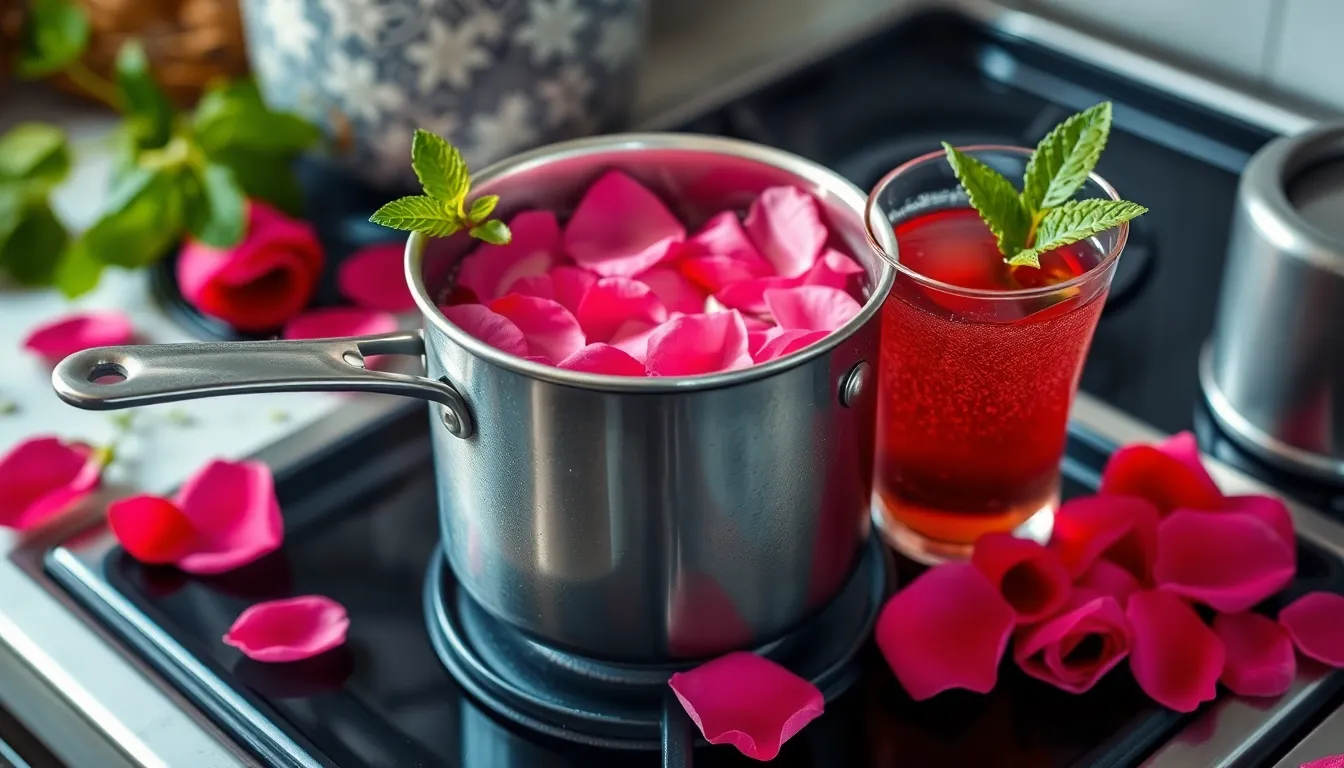
Now that we have our ingredients and equipment ready, let’s walk through the simple process of creating this aromatic rose petal tea. The following steps will guide us through each stage to ensure perfect results every time.
Prep the Rose Petals
We begin by gathering 2 cups of gently packed fresh rose petals or using dried petals from a trusted health shop. Fresh petals should be shaken gently over a sink to remove any debris or small insects that might be hiding among the delicate layers.
Rinsing the petals with fresh water helps eliminate dirt and residue, though we should note this step may slightly reduce the natural fragrance. For dried petals, we can skip the rinsing process entirely since they’re already processed and clean.
Our fresh petals work best when measured at about 2 cups of gently packed volume, ensuring we have enough material for a flavorful batch without overwhelming the delicate taste.
Boil the Water
We fill our kettle with fresh, filtered water and bring it to a rolling boil over medium-high heat. The quality of water significantly impacts the final taste, so we always recommend using filtered water when possible.
Once the water reaches a full boil, we’re ready to move to the steeping phase. Timing is important here since we want the water hot enough to extract the rose essence without scorching the delicate petals.
Steep the Tea
We have two effective methods for extracting the maximum flavor from our rose petals.
Steeping Method: We place our prepared rose petals in a pre-warmed teapot and pour 3 cups of boiling water over the 2 cups of petals. After covering the pot completely, we let the mixture steep for 20 to 30 minutes, allowing the petals to release their essential oils and create that beautiful pink color.
Simmering Method: We place the rose petals directly in a saucepan over medium-high heat and cover them with fresh cold water. Bringing the mixture to a gentle simmer, we let it cook for 5 minutes or until the petals visibly darken and release their color into the water.
Strain and Serve
We use a fine tea strainer to transfer our finished tea into individual cups, removing all petal pieces for a smooth drinking experience. The liquid should display a lovely pink hue and emit a gentle floral aroma.
Honey or sugar can be added to taste, improving the natural sweetness of the rose petals. For additional complexity, we might add a splash of lemon juice or a drop of vanilla extract to complement the floral notes.
Our rose petal tea is now ready to enjoy hot, or we can chill it for a refreshing iced version served over ice with fresh mint sprigs as garnish.
Variations and Flavor Combinations
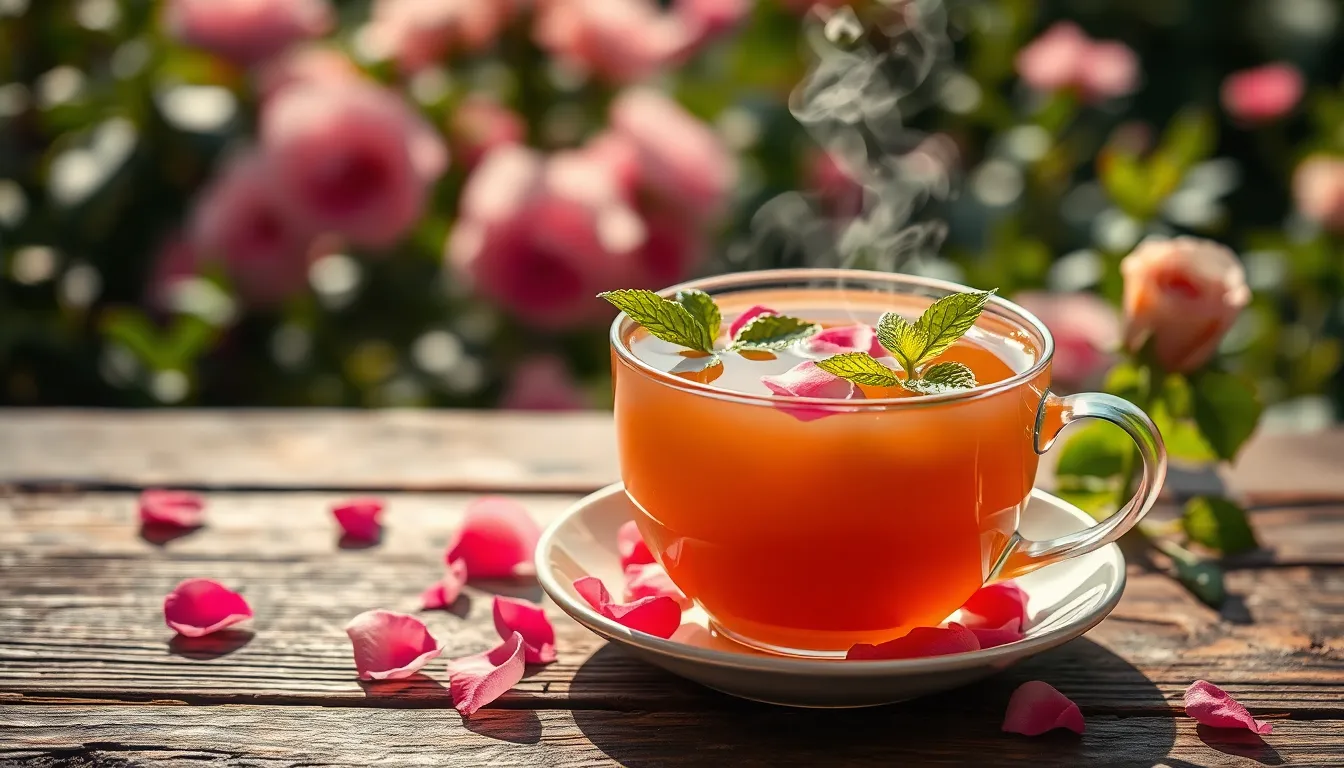
We can transform our basic rose petal tea into many delightful variations by incorporating complementary ingredients. These creative combinations enhance the natural floral notes while adding unique flavor profiles and health benefits.
Honey Rose Petal Tea
This classic variation sweetens our rose petal tea naturally while adding antibacterial properties. We prepare our basic rose petal tea following the standard method with 2 cups fresh fragrant rose petals and 3 cups water. After straining the tea into our cups, we stir in honey to taste, starting with one teaspoon per cup and adjusting according to preference. The honey complements the rose’s delicate floral notes without overpowering them, creating a perfectly balanced and soothing beverage that soothes the throat and provides natural energy.
Rose Petal and Chamomile Blend
We create this calming combination by mixing rose petals with dried chamomile flowers for enhanced relaxation benefits. In our saucepan, we combine equal parts fresh rose petals and dried chamomile flowers, then cover with water and bring to a gentle simmer. After simmering for 5 minutes, we strain the mixture and serve immediately. This blend offers the best of both herbs: rose petals provide antioxidants and a beautiful floral taste, while chamomile adds its renowned calming properties and subtle apple-like notes.
Iced Rose Petal Tea
Perfect for warm weather, this refreshing variation transforms our hot tea into a cooling summer beverage. We steep 4 tablespoons of dried rose petals in 5 cups of boiling water for at least 30 minutes to extract maximum flavor. After straining the concentrated tea, we pour it into a pitcher filled with ice and add honey to taste while the tea is still warm for better dissolution. We garnish our iced rose petal tea with fresh mint sprigs and a few rose petals for visual appeal, creating an elegant drink that rivals any spa beverage.
Storage Tips
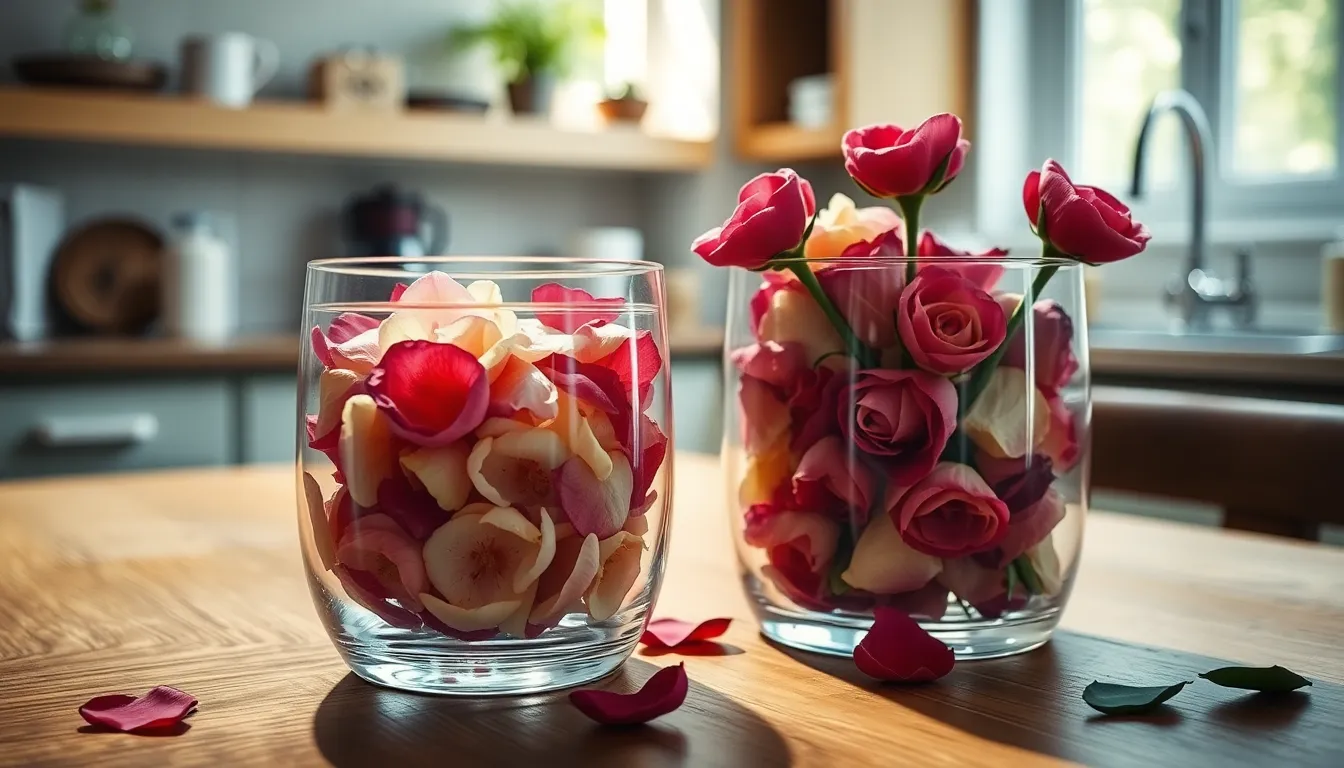
We understand that proper storage preserves the delicate quality of rose petals for multiple batches of tea. Following these storage methods ensures your petals maintain their aromatic properties and flavor intensity.
Storing Fresh Rose Petals
Fresh rose petals require careful handling to preserve their delicate nature and essential oils. We recommend wrapping them in a damp paper towel before placing them inside an airtight container in the refrigerator.
Store fresh petals immediately after harvesting to maintain peak freshness. The moisture from the damp paper towel prevents wilting while the airtight container protects against contamination and odor absorption.
Use fresh rose petals within 1 to 2 days of storage for optimal flavor and aroma. Beyond this timeframe the petals begin to lose their essential oils and may develop brown spots or an unpleasant texture.
Avoid washing fresh petals until you’re ready to brew your tea. Premature washing introduces excess moisture that accelerates deterioration and reduces the petals’ natural flavor concentration.
Storing Dried Rose Petals
Dried rose petals offer longer storage life when kept in proper conditions. We store our dried petals in airtight containers made of glass or food-grade plastic to prevent moisture absorption and maintain their concentrated flavor.
Position your storage containers in a cool dark place such as a pantry or cupboard away from direct sunlight. Heat and light exposure degrades the petals’ natural compounds and diminishes their aromatic qualities over time.
Keep dried petals away from strong odors and moisture sources in your kitchen. The porous nature of dried petals makes them susceptible to absorbing surrounding flavors that can alter your tea’s taste profile.
Properly stored dried rose petals retain their flavor and aroma for several months to a full year. Check periodically for signs of moisture or mold and discard any petals that show deterioration to maintain the quality of your remaining supply.
Health Benefits of Rose Petal Tea
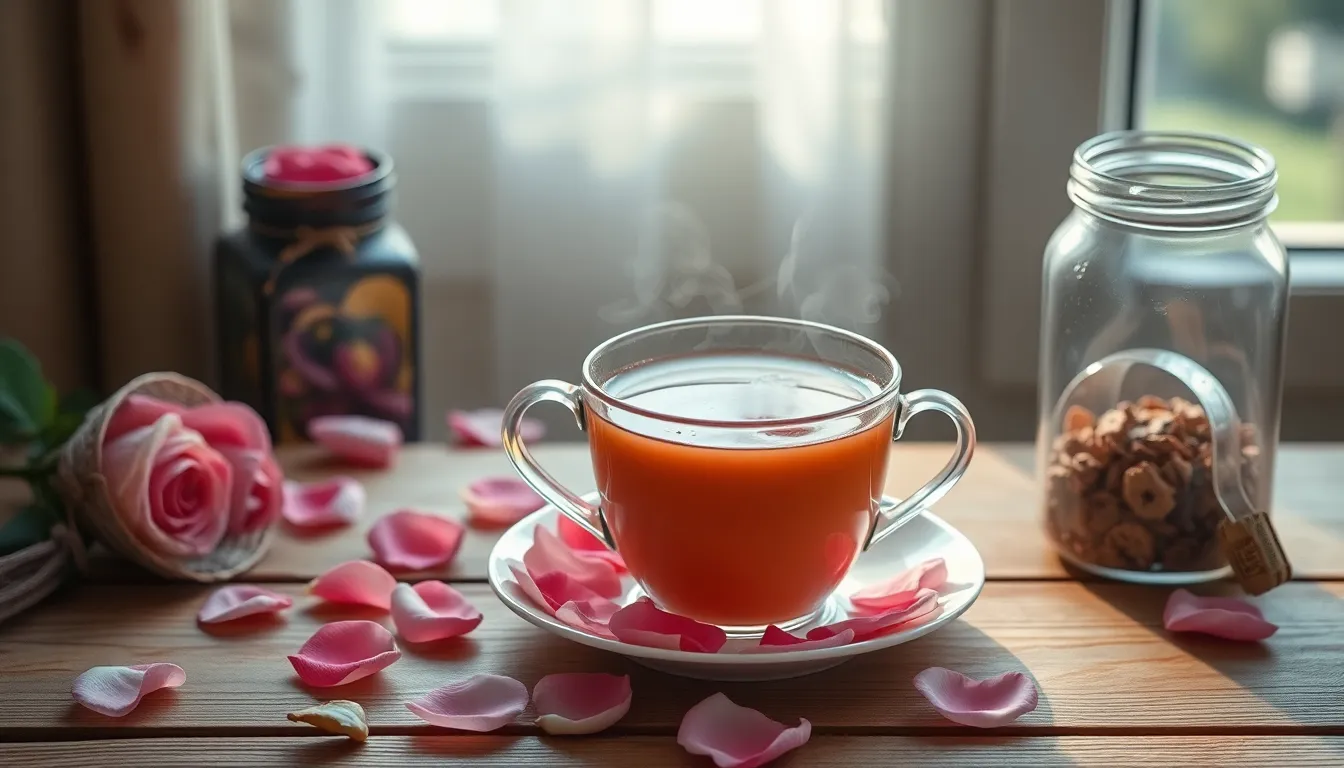
We discover that rose petal tea offers remarkable health advantages beyond its delightful taste and aroma. Our research reveals this floral beverage contains powerful compounds that support overall wellness in multiple ways.
Antioxidant Protection stands as one of the most important benefits we find in rose petal tea. The beverage contains high concentrations of polyphenols and vitamin C that help protect our cells from oxidative stress. These antioxidants work to neutralize harmful free radicals in our bodies while supporting cellular health and longevity.
Anti-inflammatory Properties make rose petal tea particularly valuable for those seeking natural wellness answers. We observe that regular consumption may help reduce inflammation throughout the body. This benefit supports our overall health by potentially decreasing the risk of chronic inflammatory conditions.
Digestive Support emerges as another compelling reason to incorporate rose petal tea into our daily routine. The gentle compounds in rose petals reportedly soothe the digestive tract and help reduce uncomfortable bloating. We find this makes the tea an excellent after-meal beverage for promoting digestive comfort.
Hydration and Relaxation benefits work together to create a uniquely calming experience. We appreciate how this caffeine-free beverage acts as both a hydrating drink and a natural relaxation aid. The soothing properties may help promote restful sleep when enjoyed in the evening hours.
Vitamin Content provides additional nutritional value that we often overlook in herbal teas. Rose petals offer small but meaningful amounts of vitamins, particularly vitamin C, which supports our immune system function and skin health. This natural vitamin source makes our homemade rose petal tea both delicious and nutritious.
| Health Benefit | Key Components | Primary Effects |
|---|---|---|
| Antioxidant Protection | Polyphenols, Vitamin C | Cellular protection, Free radical neutralization |
| Anti-inflammatory | Natural compounds | Reduced inflammation, Chronic condition support |
| Digestive Aid | Gentle plant compounds | Digestive tract soothing, Bloating reduction |
| Relaxation | Calming properties | Stress relief, Sleep promotion |
| Vitamin Support | Vitamin C, Trace vitamins | Immune support, Skin health |
We emphasize the importance of using clean, pesticide-free petals to maximize these health benefits while avoiding harmful contaminants. The caffeine-free nature of rose petal tea makes it suitable for most people, allowing us to enjoy these wellness advantages throughout the day without concerns about sleep disruption.
Serving Suggestions
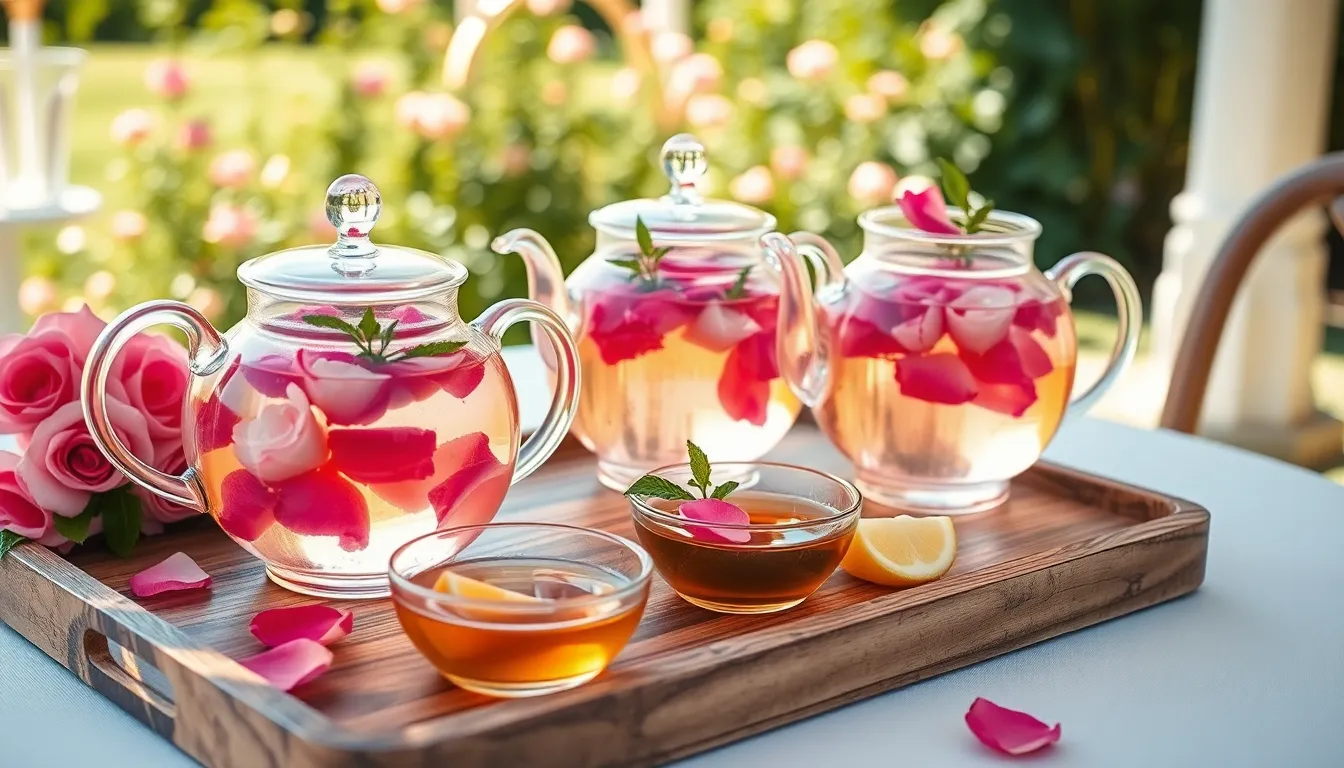
We love presenting rose petal tea in ways that highlight its natural elegance and enhance the overall experience. The beautiful pink hue of this floral beverage deserves thoughtful presentation that matches its delicate flavor profile.
Hot Serving Options
For traditional hot service, we recommend pouring the freshly strained tea into pre-warmed teacups or clear glass mugs to showcase the lovely color. A drizzle of honey adds natural sweetness while complementing the floral notes perfectly. We often garnish each cup with a single fresh rose petal floating on the surface for an Instagram-worthy presentation.
Clear glass teapots work beautifully for serving guests, allowing everyone to appreciate the tea’s gorgeous pink tone. We suggest placing the teapot on a wooden tray alongside small bowls of honey, lemon wedges, and fresh mint sprigs so guests can customize their cups to taste.
Iced Tea Presentation
Our favorite summer serving method involves straining the concentrated tea into a glass pitcher filled with ice cubes. We add honey while the tea is still warm to ensure proper dissolution, then garnish with fresh rose petals and mint sprigs for an elegant touch. Mason jars make charming individual serving vessels for outdoor gatherings.
For special occasions, we freeze individual rose petals in ice cubes beforehand. These floral ice cubes slowly release color and fragrance as they melt, creating a stunning visual effect in tall glasses.
Enhanced Flavor Additions
A splash of rosewater intensifies the floral experience without overwhelming the delicate tea base. We add just a few drops per cup to avoid overpowering the natural rose petal flavor. Fresh lemon juice brightens the taste while helping preserve the tea’s beautiful pink color.
Vanilla pods steeped alongside the rose petals create a luxurious flavor combination that transforms this simple tea into a sophisticated beverage worthy of afternoon tea service.
Troubleshooting Common Issues
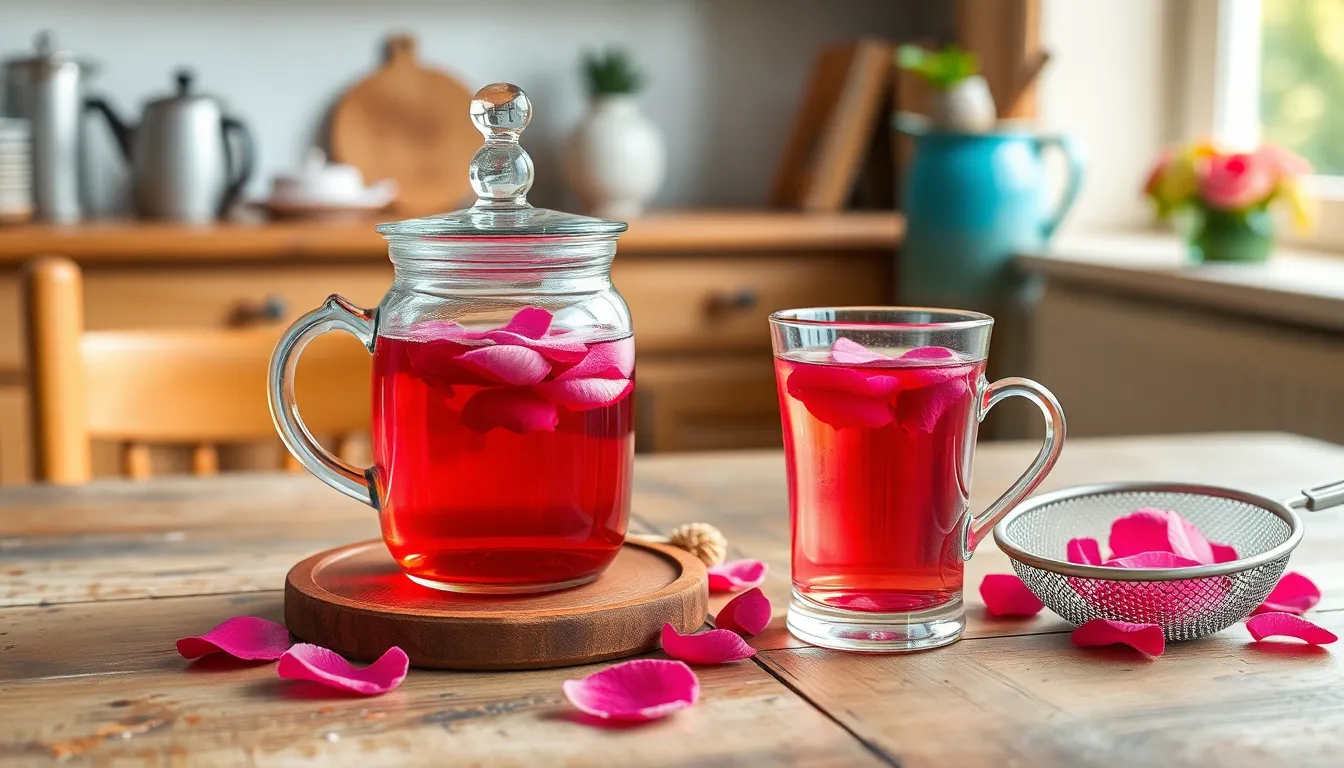
Even the most experienced tea enthusiasts encounter challenges when brewing rose petal tea. We address the most common problems to help you achieve perfect results every time.
Weak or Flavorless Tea
Your tea lacks the expected floral intensity when you use insufficient petals or steep for too short a time. We recommend increasing the petal quantity to 3 cups of fresh petals or 5 tablespoons of dried petals for stronger flavor. Extend steeping time to 25-35 minutes for fresh petals and up to 40 minutes for dried varieties. Old or poor-quality petals also produce weak tea so always source fresh organic roses or properly stored dried petals.
Bitter or Astringent Taste
Over-steeping creates unpleasant bitterness that masks the delicate rose flavor. We suggest limiting steeping time to 30 minutes maximum for fresh petals and monitoring the color development. Water temperature above 212°F can extract harsh compounds so allow boiling water to cool for 1-2 minutes before pouring. Remove petals immediately after the recommended steeping time to prevent over-extraction.
Cloudy or Muddy Appearance
Inadequate straining leaves petal debris in your finished tea. We use a fine-mesh strainer or cheesecloth to achieve crystal-clear results. Disturbing the petals too much during steeping can release sediment so avoid stirring or pressing the petals. Fresh petals should be gently rinsed before use to remove any dirt or insects that could cloud the tea.
Loss of Pink Color
Rose petal tea naturally loses its vibrant pink hue when exposed to acidic conditions or extended heat. We preserve color by adding lemon juice after the tea cools slightly rather than during brewing. Store prepared tea in the refrigerator and consume within 24 hours to maintain optimal color. Using petals from deep pink or red roses provides more stable pigmentation than lighter varieties.
Overwhelming Perfume Taste
Heavily fragranced commercial roses can produce soapy or overpowering flavors unsuitable for tea. We recommend using culinary-grade roses like Damascus or Centifolia varieties specifically grown for consumption. Avoid roses treated with chemicals or those purchased from florists. Wild roses or garden varieties often provide more balanced flavors than ornamental types.
Inconsistent Results
Variations in petal freshness water quality and timing create unpredictable outcomes. We maintain consistency by measuring petals by weight rather than volume and using filtered water at the same temperature each time. Keep detailed notes about petal sources steeping times and results to identify your preferred combinations. Fresh petals should always be used within 48 hours of harvesting for predictable flavor development.
Conclusion
We’ve walked through everything you need to create this elegant floral beverage from start to finish. With just a few simple ingredients and basic equipment you can transform ordinary afternoons into luxurious tea moments.
Whether you prefer the classic hot version or refreshing iced variations our rose petal tea recipe offers endless possibilities for customization. The health benefits and stunning pink color make it perfect for both everyday enjoyment and special occasions.
Remember to source quality organic petals and follow proper storage techniques to maintain optimal flavor. With these tips and troubleshooting answers you’ll brew perfect rose petal tea every single time.
Start brewing today and discover why this ancient floral tea has captivated tea lovers for centuries. Your taste buds will thank you for this delightfully aromatic adventure.
Frequently Asked Questions
What type of roses should I use for rose petal tea?
Use organic, food-grade roses like Damascus or Centifolia varieties for the best flavor and safety. Avoid roses treated with pesticides or chemicals. Fresh petals should be vibrant and collected in the morning when essential oils are most concentrated. You can also use high-quality dried rose petals from trusted suppliers.
How much rose petals do I need for one cup of tea?
Use about 2 tablespoons of fresh rose petals or 1 tablespoon of dried rose petals per cup of water. For a stronger flavor, you can increase the amount to 3 tablespoons of fresh petals. Adjust the quantity based on your taste preferences and the potency of your rose petals.
What’s the ideal water temperature for brewing rose petal tea?
Heat water to just below boiling point, around 200-212°F (93-100°C). Boiling water helps extract the delicate floral compounds from the petals effectively. Using filtered water is recommended to ensure the purest taste and avoid any chlorine or mineral interference with the tea’s delicate flavor profile.
How long should I steep rose petal tea?
Steep rose petal tea for 5-10 minutes for optimal flavor extraction. Fresh petals may require slightly longer steeping time than dried ones. Don’t over-steep as it can make the tea bitter. Use a timer to ensure consistency and taste-test to find your preferred strength.
Can I drink rose petal tea cold?
Yes, rose petal tea makes an excellent iced beverage. Brew the tea using the hot method, then let it cool completely before refrigerating. Serve over ice and garnish with fresh mint leaves and rose petals for an elegant presentation. The tea retains its beautiful pink color when chilled.
How should I store fresh and dried rose petals?
Store fresh rose petals wrapped in damp paper towels inside an airtight container in the refrigerator for 1-2 days. Keep dried rose petals in airtight containers in a cool, dark place away from moisture and strong odors. Properly stored dried petals maintain their flavor for several months to a year.
What are the health benefits of rose petal tea?
Rose petal tea is rich in antioxidants, vitamin C, and polyphenols that help fight free radicals and support cellular health. It has anti-inflammatory properties, aids digestion, promotes hydration, and provides relaxation benefits. Being caffeine-free, it’s suitable for drinking throughout the day without affecting sleep.
Why is my rose petal tea weak or flavorless?
Weak tea usually results from using too few petals or insufficient steeping time. Increase the amount of rose petals to 3 tablespoons per cup or extend steeping time to 8-10 minutes. Ensure you’re using fresh, high-quality petals and water that’s hot enough to extract the floral compounds effectively.
Can I add sweeteners or other flavors to rose petal tea?
Yes, honey is the most popular natural sweetener that complements rose tea’s floral notes. You can also add lemon juice to brighten the flavor and preserve the pink color, or try vanilla extract for depth. Rosewater, fresh mint, or chamomile can create delightful flavor combinations.
How can I prevent my rose petal tea from turning bitter?
Avoid over-steeping the tea beyond 10 minutes, and don’t use water that’s too hot if using delicate fresh petals. Ensure you’re using culinary-grade roses rather than decorative ones. Strain the tea promptly after steeping and taste-test regularly to find your optimal brewing time and petal ratio.

